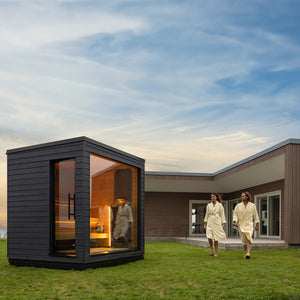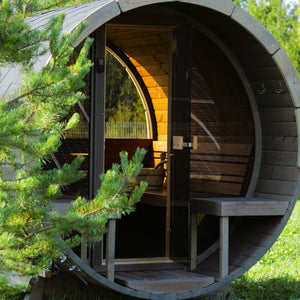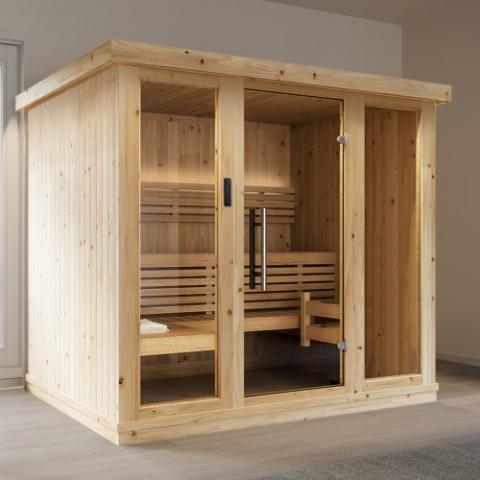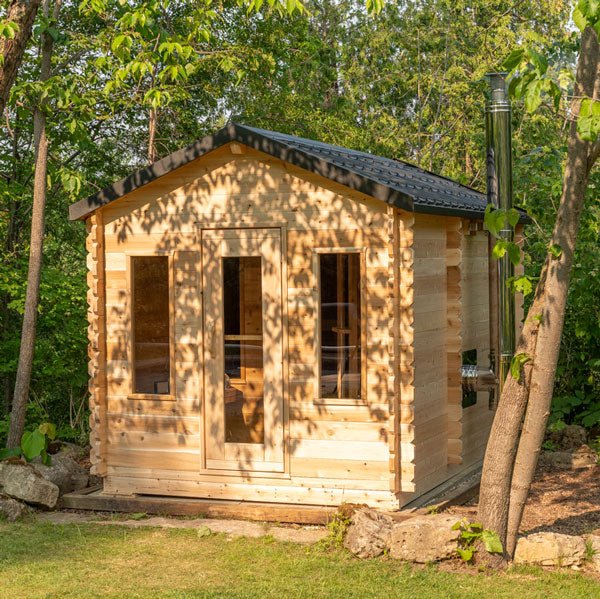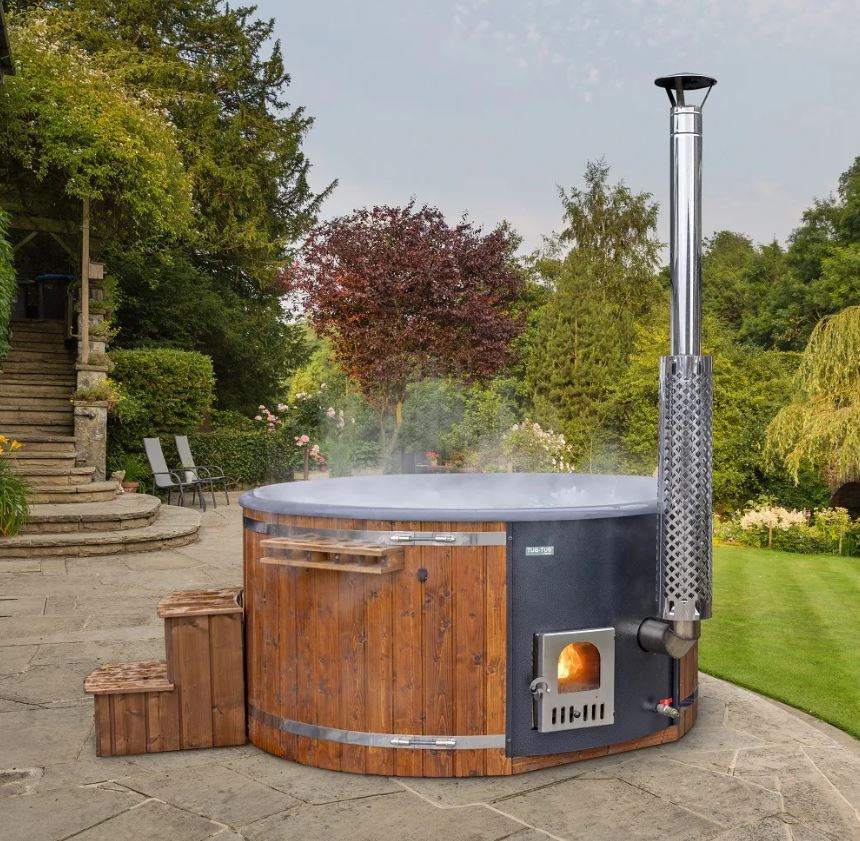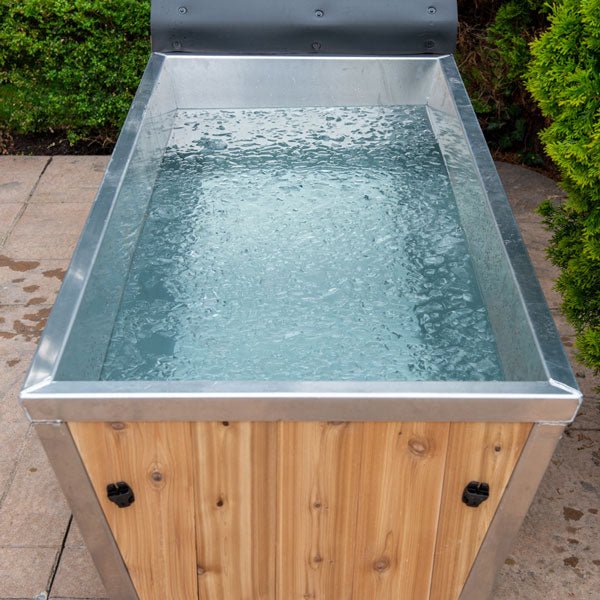
Is a Sauna Good for a cold? Can Sitting in a Sauna Help Common Cold symptoms?
As we become more accustomed to life post-pandemic, it's become increasing important to distinguish between colds, flu, covid and other illnesses. Symptoms of hay fever in the summer could also be a sign of a common cold or easily mistaken as covid. None of us enjoy those runny noses or achy muscles so in this article we're going to get bottom of the question: can sauna’s really prevent us from catching colds?
Table of Contents
Why Do We Catch Colds?
The most common symptoms of a cold are a blocked or runny nose; a sore throat; headaches; muscle aches; coughs; sneezing; a raised temperature; pressure in your ears and face; loss of taste and smell.
It is paramount to stress here, that a cold (a word to describe the symptoms) is caused by a viral infection in your nose and throat. The name for the illness suggests that its symptoms are as a result of the weather; but this is in fact a myth.
Viruses cause colds; not the rain, snow, wind, or going outside with wet hair.
Scientists are yet to confirm what the definitive correlation is between colder seasons and catching colds, but a Finnish study in 2016 suggested a few ideas:
- Viruses live longer and replicate faster and more aggressively in colder temperatures. A rhinovirus is the most common type of virus to cause a common cold. Others include Adenoviruses and enteroviruses.
- Exposure to cold air affects our immune function. It is harder for our bodies to fight off the virus in colder times.
- In the colder seasons, we spend most of our time indoors to stay warm. This means more people in more confined spaces, making it easier for viruses to pass from person to person.
The Life Cycle Of A Cold
- the Incubation period… where the virus enters your body and makes itself at home. This period usually lasts between 12 hours to 3 days. The incubation period is the point from which you are infected before symptoms start to show.
- Symptoms appear and progress (list common symptoms again?) (Talk about distinguishing colds from flu and covid).
- Remission where symptoms begin to fade and gradually go away. This is usually from day 3-10.
- Recovery looks like symptoms diminishing completely. Although some mild symptoms can potentially linger. A cough is the most common symptom to linger, especially if you are a smoker
Can a Sauna Help Treat a Cold or Flu Virus?
Before we dive into how beneficial saunas are for colds, It is key to understand that a common cold has no cure. It’s also important to be clued up on distinguishing between a cold, flu, covid and allergies It is also important to get clued up on distinguishing between a cold, flu and covid.
If you are in good health and your immune system is on your side, you can usually trust your body to rid itself of the illness in 7-10 days. The over the counter products for colds will only relieve your symptoms.
Over centuries, word of mouth has spread to suggest that saunas are beneficial to one’s overall health. History suggests that sweating is good for fighting off illnesses and we have continued to believe it. Steam as a remedy for colds and illnesses has also been lauded over generations. And whilst a lot of ancient medicinal claims can now be deemed unreliable or disproven by modern science, we can confirm that hot steam can clear congestion. The use of pine, sandalwood and other tree derivatives in pagan rituals and witchcraft are still used today for steam inhalation when sick. Saunas are made from wood, and they produce steam – we can see how medicinal beliefs interweave throughout different cultures and historical periods. We’ve also followed in the footsteps of the ancient romans, regarding their renowned use of baths – a regular regimen for health.
Steam can widen your airways and help decongest, however saunas will not help to decrease the duration of your cold. We’ve all heard “sweat it out” regarding viral infections like cold and flu however, there's no evidence to back this up.
Do Saunas Relieve Cold Symptoms?
- We must be aware that if you are already infected with a virus (even if you are non-symptomatic), sauna treatment will not aid your recovery. Stress and dehydration are the predominant reasons why this is the case.
- We are often told to drink more water and keep up our fluids when suffering with a cold, so it seems logical that sweating out bodily fluids in a sauna when ill, might actually do more harm than good.
- Now that we know sauna exposure does not relieve cold symptoms or aid our recovery, we can explore how regular sauna exposure can prevent catching colds.
- Saunas can reduce your chances of contracting a cold, provided you use them regularly and are taking other measures to support your immune system. Investing in a home sauna for private use would also eliminate the risk of contracting any viruses from another person in public saunas.
Do Saunas Strengthen Your Immune System?
1990 Austrian study determined that regular sauna use could help to prevent catching colds. The study followed 50 individuals over the course of six months. Half of the individuals were instructed to use saunas regularly, and the other half of the volunteers did not step foot in a sauna throughout the duration of the study.
The study determined that the average duration and severity of common colds for those with regular sauna exposure did not differ significantly from the volunteers without. However, there were significantly fewer episodes of common colds in the group of volunteers who were sauna bathing frequently.
Infrared saunas have been proven to boost our body’s fight against pathogens and toxins. It’s difficult for the body to completely eliminate all toxins naturally, particularly the ones that loiter in fat cells underneath our skin…
But infrared saunas can target these sneaky subdermal fat cells with their infrared light. The infrared light combined with sweating will help your lymphatic system do its thing.
The lymphatic system is responsible for the optimal function of our immune responses. It is inherently interconnected with the immune system and it’s easy to get mixed up between the two:
- The functions of the lymphatic system include protecting your body from illness-causing invaders, maintaining body fluid levels, absorbing digestive tract fats, and removing cellular waste. Think of it as the body’s very own sewage system.
- The function of the immune system is to defend your body against infection.
Therefore, through regular sauna exposure, we are amplifying the functions of our lymphatic system, and in turn - enhancing our immune responses.
Heat stress from the sauna can replicate an artificial fever, that your immune system will respond to by accelerating the production of white blood cells (your body’s germ-fighting cells). Sauna bathing can also increase the bodily production of heat shock proteins, which reduce inflammation, encourage natural healing, and helps to protect non-foreign cells.
When the high temperatures of a sauna induce a faux fever, our body creates an inhospitable environment for foreign bodies (germs, viruses, bacteria). A core temperature of 38.5ºC is commonly considered a fever. This body temperature can weaken and even kill some viruses and bacteria.
Remember though, that if you are already infected with a cold/virus, allowing your body to experience an artificial fever could be straining for it and potentially do more harm than good. Moreover, if you are sick with a cold or fever, your body is basically doing sauna therapy independently.
The most effective, safe, and non-abrasive way to create an artificial fever is to use an infrared sauna. The infrared sauna heats your core from the inside out using lower temperatures; preventing hot air from damaging your skin whilst allowing your body to reach a maximum temperature. The infrared sauna also depletes any discomfort and risks associated with high air temperatures.
How to Use a Sauna to Boost Your Immune System.
Frequency
2-3 home sauna sessions a week is the recommended frequency to improve your immune system. By using a sauna for 20 minutes 2-3 times a week instead of just once, you could reduce your risk of getting pneumonia by 21%. A 25 year long Finnish study concluded these results. Another study by the same research group following participants for over 25 years found that by using a sauna 2-3 times a week, you could lower your risks of respiratory disease by up to 27%. This study also concluded that by using the sauna 4 or more times a week could lower your risk of respiratory disease by 41%!
Temperature
The temperature inside your infrared sauna will have no effect on the temperature in your home. As mentioned earlier in the article, infrared saunas are more efficient as they require lower temperatures to heat your body from the inside out, unlike traditional saunas that are wooden and mostly outdoors. A home infrared sauna functions well at a temperature somewhere between 39°C (120°F) and 60°C (140°F). Traditional saunas require a temperature between 66°C (150°F) and 82°C (180°F) which many people find this level of heat uncomfortable. The general advice is to start on the lower end of the recommended temperature range if you are a beginner to sauna exposure.
When to Use
- After a shower: whatever time of day you choose to use your sauna, make sure to make sure to take a shower in order to open your pores and prevent bringing dirt or germs into the sauna. Make sure you dry off well – if your skin is already moist, you won’t sweat as quickly or as much.
- A morning sauna session may bring a sense of rejuvenation to your day, but other people might prefer to use a sauna in the evening as a way to wind down, relax and even fight insomnia. However if you are using a sauna to prevent catching colds and improve immunity, morning is the most appropriate time of day for a sauna session as this when your body is at its most rested, allowing your body to reap the health rewards more effectively. In summary, using a sauna is beneficial at any time of day depending on your reason of use, but when you are most rested is when your body will work with you to support and boost your immune system.
Adding Cold Showers
Switching from extreme temperatures to unlock health benefits is a centuries old tradition founded by the Scandinavians. Before that, we can trace the tradition back to at least 500 BC where ancient Egyptians, Romans and Greeks would make us of ice cold baths for health benefits.
In order to achieve the best results for your immune system, taking a cold shower after your sauna session is highly recommended. The cold plunge will increase your lymphatic circulation, in turn accelerating your body’s ability to protect you from illnesses. The cold water from the shower after your sauna session will tighten your lymph vessel. This will be advantageous; promoting a quicker removal of waste from your body, boosting white blood cell’s resistance to germs, bacteria and other foreign bodies. This will also enhance your body’s detoxification system. It is recommended to stay in the cold shower for at least 20 seconds as a beginner, increasing the duration as you become more accustomed to the routine.
However, the addition of a cold shower straight after sauna use it is not recommended for anyone and everyone. For example someone with Raynaud’s phenomenon: a common condition that affects the blood supply to certain parts of the body – usually the fingers and toes, and commonly caused by cold temperatures. The extreme temperature change for someone with Raynaud’s can cause chilblains. The extreme temperature change may also be stressful for the body if you have a high blood pressure, or are pregnant. In summary, you should seek a doctors advice before partaking in post-sauna cold showers.
Key points to take away
- Regular sauna exposure can help to prevent you from catching colds. By regular we mean 2-3 sessions a week for 20 minutes. You can increase this to 4 times a week or more.
- Regular sauna exposure can enhance the functioning of our immune system and in turn strengthen our immune responses.
- Sauna exposure will boost the body’s production of germ-fighting cells as well as heat shock proteins which can help to reduce inflammation and encourage natural healing.
- Infrared saunas are the most effective type of sauna for boosting immunity.
- You can fit your sauna sessions into your personal routine and it doesn’t matter what time of day that is. However, if you are using a sauna to boost your immune system, a morning session is best as this is when you are most rested.
-
There is not yet any cure for the common cold, thus sauna exposure will not accelerate or cure your recovery from a cold.
- If you are already infected with a cold, sauna exposure can be harmful so use with caution.
- So long as you don’t have any underlying circulatory issues, a cold shower after a sauna session can improve your body’s ability to fight illnesses
About the Author
I'm Jasper Knight, the founder of SecretSaunas.com. During my travels through Finland and Scandinavia in 2018 I was introduced to the thrilling local ritual of taking daily hot saunas and then cooling off by plunging into the dark icy waters of a frozen lake. This experience was so fulfilling that it felt like an addiction. My desire to return to the forests and lakes of Northern Europe led me to set up Secret Saunas with the mission of bringing that authentic Finnish sauna experiences home.
